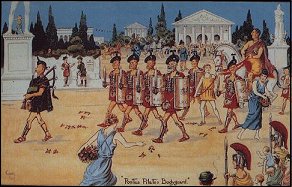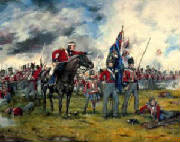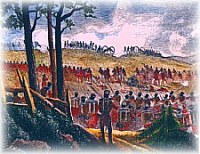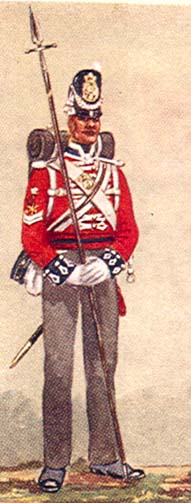|

|
| Pontius Pilate's Bodyguard |
The Royal Scots were raised in 1633 by Sir John Hepburn when he was given a Royal Warrant to raise a
Regiment to fight in France. During their extended service in France, the Royal Scots earned their nickname, 'Pontius
Pilate's Bodyguards.' A dispute arose between the Royals and the French Regiment of Picardy, both arguing that they
deserved the coveted place on the right of the line. The French Regiment asserted that they were the senior regiment,
having been on guard at the Crucifixion. The Royals claimed that had they been there too, the body would not have gone
missing! The Royals have proudly maintained the nickname ever since.
Since the seventeenth century, the Royals have fought in almost every British war up to and including the
Second Gulf War. This makes the Royal Scots the oldest British Regiment of Foot serving today. It is this proud
tradition that we seek to capture when we recreate the actions of the Royal Scots in the War of 1812.

|
| Two centuries of Royal Scots |

|
| Royal Scots at Waterloo |
In the early nineteenth century, the Royal Scots (or the Royal Regiment as they were known until 1812) had
four distinct battalions serving in the West Indies (1st Battalion), Egypt and India (2nd), the Penninsula (3rd) and in Britain
(4th). All four battalions served with distinction, and, by 1812, the Regiment had earned thirteen battle honours.
They would add seven more before peace returned in 1815.
When the United States declared war on Great Britian, the first battalion left the West Indies and sailed
for Quebec. Although the battalion was suffering from their service in the disease-ridden West Indies, they welcomed
300 recruits from the depot and arrived in Lower Canada with 1,216 officers and men. While the battalion was scattered
between Quebec and Kingston for much of 1812 and 1813, the Light Company was involved in training the Canadian militia in
light infantry tactics.

|
| Battle of Lundy's Lane |
The Royals eventually recovered and saw much action in Upper Canada during the war. They fought at
Sacket's Harbour, Buffalo and Fort Niagara in 1813 and at Longwoods in March of 1814. Their greatest contribution to
the war, however, would come in the summer of 1814. The Royals fought the battles at Chippewa, Lundy's Lane and Fort
Erie in July and August. The Royals suffered very high casualties, but remained steady throughout the campaign and were
later awarded the battle honour NIAGARA for their service.

When the Royal Scots sailed from the West Indies, they were still wearing uniforms that would
be very unsuitable in the Canadian climate. They had no greatcoats, unlined uniform coats, light linen trousers and
round caps. When they arrived in Quebec, therefore, they had to be almost completely reoutfitted. Fortunately,
ships from Britain to Quebec were frequent and the Quebec merchants were more than willing to help the government - for a
price. To learn more about the uniforms that the Royal Scots wore during the War of 1812, click on the Colour Sergeant
to the left.
|

